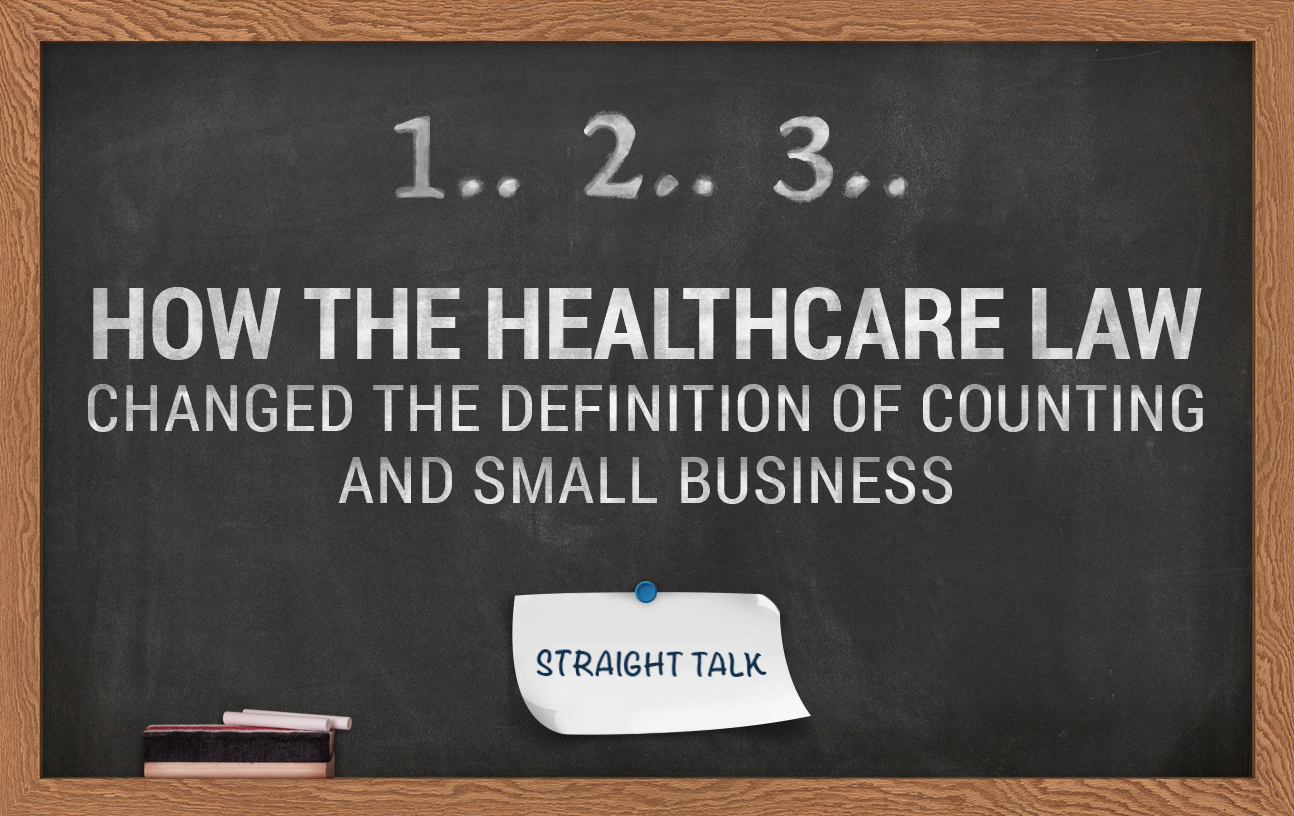Since 2009, I’ve given more than 800 presentations in Louisiana alone on healthcare reform and cost trends. Almost all of these were to business audiences, whose benefit offerings have been drastically affected by healthcare reform.
Although the 2,800-page law itself was quite wordy, it pales in comparison to the federal regulations to enforce the law sent out by the IRS, U.S. Department of Labor and federal Center for Medicare and Medicaid Services (CMS) over the past five years. I stopped counting at 50,000 pages!
So what’s the average business person supposed to make of this torrent of rules and regulations? How on earth does he know what to focus on? If you own a business, could you be running up thousands of dollars in fines without knowing it?
I’m going to take several posts to talk compliance, giving you the Straight Talk answer on where to start looking for answers.
Keep in mind, while I have a ton of credentials, none of them say “attorney” or “CPA,” so I’m going to give you guidelines and questions to ask when you meet with your insurance agent, broker, consultant, CPA, benefits attorney or human resources folks. Do not consider this tax or insurance advice; think of it as “peace of mind” advice. This is a GREAT time to keep your experts close by.
Straight Talk on the basic compliance requirements of the healthcare law is focused around what I call the Five Key Questions. Although not a complete list, it should at least get you started. If you don’t want to wait for the explanations or the series, advanced students can read ahead by just typing “2014-03082” into your favorite search engine — if you’re in the mood to read the Federal Register, that is.
Today, we start with Question 1 and lessons on how to count. The healthcare law invented its own way of counting your employees, and the fines for getting it wrong can be quite substantial.
In Louisiana, if your MLR count is more than 50, your carrier can offer you MANY more plan options because they don’t have to meet the metal level standards. That can affect your choices and rates, so make sure you get the MLR count correct.
Question 1: How Many Employees Do I Have?
Ah, I miss the good old days, when counting was something they taught you in kindergarten. The Healthcare Law requires a business, no matter its size, to maintain two different counts of its employees. They are very different and used for very different purposes, but both critical.
- The Medical Loss Ratio (MLR) count—every year, your health insurance company will send you a survey that you complete by counting all your employees (full time, part time, seasonal, ownership, everybody!) at the beginning and end of the year, then divide that number by 2.So # of employees in January + December / 2 = MLR count. Your insurance company is required to gather this data for two reasons under the healthcare law:
- First, to see what products they may legally sell you. If your number is 50 or fewer, they have to offer you a Qualified Health Plan. These plans are federally regulated, difficult to design and come in metal levels – those bronze, silver and gold plans you may have heard about.There are typically a lot fewer plans for small businesses than plans for folks with larger companies. In Louisiana, if your MLR count is more than 50, your carrier can offer you MANY more plan options because they don’t have to meet the metal level standards. That can affect your choices and rates, so make sure you get the MLR count correct.
- Second, carriers gather this data to see how much overhead the insurance company can use to administer your group. If you have 50 or fewer employees, the insurance company has their gross margin capped by the federal government at 20%. If you have 50 or more, the margin caps at 15%. If the company makes more money than these limits, they have to SEND THE DIFFERENCE BACK TO YOU. Again, you see how important it is to get the MLR count right.
- The Applicable Large Employer (ALE) count – Every single month of every single year of operation, businesses are required to record their payroll results in a very particular way. This counting methodology is not intuitive; you would never think to do this on your own.This information is gathered for correspondence between the company and the IRS. Your insurance company does not collect or know your ALE count. Here are the steps you should follow:
- Add up each employee who worked more than 30 hours/week (or 130 hours/month) in a given month. Count each of them as “1.”
- Add up all the hours of labor by the folks who didn’t work 130 hours, and put all those hours in a single bucket for the month. Divide the bucket by 120 (not 130).
- Take the result of the division in “b,” and add it to the number of full timers in “a.”
- That total is the full time equivalency (total FTEs) of that business for that month.
- Add up the FTEs for all 12 months in a calendar year and divide by 12.
- That number is the official ALE count for that business for that calendar year.
My favorite question about being “large” under the healthcare law: “So Mike, I’ll just split my company into a bunch of little ones, and that way I won’t have to offer insurance, right?”
So, you might ask, now that I’ve got this fancy ALE count, what do I do with it? Yeah, this is where the fun begins:
If your ALE count is from 0-49.99 (yes, you can carry it to two decimal places!), then you are considered a SMALL business under the employer mandate (you can browse for “26 US 4980h sections a) and b)” if you are feeling adventurous), and the mandate does not apply to you. You have no federal requirement to offer your employees health insurance; only state laws apply.
IF your ALE count is 50.00 or above, then you are considered an Applicable Large Employer (ALE) under the healthcare law, and a whole host of new regulations apply to your business, including a requirement that you either offer coverage to your full-time employees and their dependents, or you could pay fines.
I’m going to cover the implications of the ALE count, and how to be in compliance, in the next post in this series called, “Ok, so I’m an ALE. What does THAT mean?” The focus of that blog will be on avoiding fines.
Keep in mind that your result from a calendar year computation determines your size for the NEXT calendar year.
If my 2015 monthly average shows I’m a large employer, then in 2016, no matter how it goes, I’m a large employer for 2016.
My favorite question about being “large” under the healthcare law: “So Mike, I’ll just split my company into a bunch of little ones, and that way I won’t have to offer insurance, right?”
Sorry. The IRS is a lot smarter than that. Years ago, they invented this code they like to call “aggregation rules” that actually look at the ownership of different companies and can force them to be grouped together for different things. In this case, aggregation rules might force those “split” companies back together to determine whether they are an ALE or not. I can’t comment on this rule (because it is 114 pages long and I’m not a CPA!), but I want you to know they exist. A qualified CPA can run the testing on your various ownership interests to see if they need to be combined for the ALE computation. Often, the whole “splitting” thing doesn’t work at all. So don’t hang your hat on it.
On a more interesting topic, it is entirely possible for business to be “large” on the MLR count and “small” on the ALE count because of the way they handle part-time labor. Be advised that keeping these counts up to date is more important now than ever, even if you only have a few employees. As your employees leak out to www.healthcare.gov, if you can’t prove your size, fines may well result in the process. We’ll cover the fines in greater detail in one of the next few compliance pieces. For today, let’s sum up:
- MLR counts are between the insurance company and your business, and are used to determine which plan you can buy and how much overhead the insurance company makes before rebates apply. They are typically collected just once per year. Every employee counts as “1.”
- ALE counts are between the company and the IRS, and are used to determine if the business must comply with the employer mandate to offer coverage [26 US 4980h a) and b)]. Severe fines can result from non-compliance. ALE counts are collected monthly for a whole calendar year and then averaged to determine the NEXT calendar year’s compliance burden.
This is step one for all businesses on the road to compliance. This counting will prove crucial in avoiding fines and problems down the road. We’ll explore those other requirements in our upcoming blogs.
For today, Happy Counting!





This is my first experience with your blog. Have you posted your thoughts/opinion on HB 1102? Though subtle in presentation it could have a major negative impact on hospitals, insurance companies/coverage and pricing and further dave to our culture.
Are you referring to Louisiana HB 1102 related to surrogacy contracts? If yes, I have no opinion on it and don’t know the nuances of the Bill. Sorry about that!….mrb